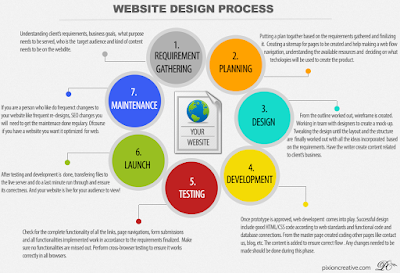As more and more businesses are switching towards websites, the business owners are looking for the most compelling and interactive websites for their businesses. They have become more curious about the web designing and development process. Here are some general steps that a business owner should expect from the website development process.
- Research, Goals & Planning
- Sitemaps
- Wireframes
- Design
- Development
1. Research, Goals & Planning
Before developing a website, or redesign a website, the developer should have a clear goal about the website, and should completely understand the client's requirements and what all is necessary to include on a web site.
Initially, it is essential that you plan your website and set the goals. A proper planning will be helpful and profitable for your organization. But the major question arises that how will a website help in achieving this goal. The answer is: an eCommerce site that sells the products. But, many of the companies have a website, which is not closes a sale, as it just supports the sales process. So it is essential to think and plan about what type of messages and content will help you to move a sale forward.
Although, the planning and research include developing, editing or organizing content. But, when it comes to research, it includes bigger branding work, where you need to examine competitors, consider target audiences, and brand positioning in the market. Before developing a website, just make sure why the visitors will come to your site, and what information they may look for.
2. Sitemap
The second important step is Sitemap. After gathering all the information regarding the goals, message, content and brand for the website, put all of them together in a sitemap. But, why a sitemap is essential? It is an organizational chart through which all the content on a website is organized, like a flowchart. Through a sitemap, you can plainly manage the organization information on the web, which can be easily understood by the visitors. Although, the visitors do not like the feeling of being confused and frustrated, so they always prefer a well-organized site, that have clear navigation, as well as logically organized content that is easy to explore.
3. Wireframes
Although, Sitemap can manage the information of the entire website. But, wireframes are used to organize information of one page, at a time. Just like blueprints, a wireframes defines the placement of content within a page. However, this can be an implied comparison because a blueprint is meant to be strictly followed, but wireframes are often more loosely created. Moreover, the wireframes show all the kind of content on a page. Although, all the types of content is important, but it may or may not show the actual position and size of items.
4. Design
Another essential step is Design. The web design should be selected on the basis of client's requirement. Depends upon the state of the brand identity, the web design should be selected. Whether, it's a new company website or redesigning of the existing client website, an innovative design will always help to get a strong brand identity and unique online presence.
5. Development
Once, the design gets approved from client side, the web development process gets started. If a website is based on Photoshop, it will be developed in HTML and CSS, or if it's more focused on content, it will be developed in WordPress. As WordPress has a Content Management System (CMS), it will help to build the sites with complete design control and user-friendly.
Conclusion
The above steps will help you to know the systematic web design and development process that one should follow at the time of making a website. Also, these steps will help you to get the customized design and development solution for your website. A large number of web design developers India are following these important steps to systematic their process and maximize their output.

No comments:
Post a Comment